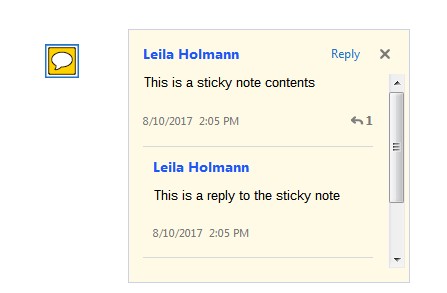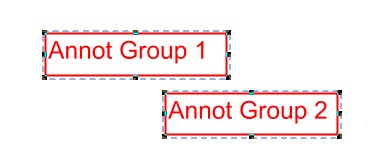This sample code shows how to get property information about reply to or grouped annotations annotations added to a PDF document. This functionality was open in the public API in v2017R1.1 in jPDFProcess library.
PDFPage p = pdfDoc.getPage(i); Vector annots = p.getAnnotations(); if(annots != null) { for(int count = 0; count < annots.size(); count++) { Annotation annot = annots.get(count); System.out.println("Annot Number " + (count + 1)); // annotation type System.out.println("Type: " + annot.getSubtype()); // annotation creator System.out.println("Creator: " + annot.getCreator()); // annotation modified date System.out.println("Modified Date: " + annot.getModifiedDate()); // annotation location on the page System.out.println("Location: " + annot.getRectangle()); // annotation subject System.out.println("Subject: " + annot.getSubject()); // annotation contents (this is the note attached to the annotation) System.out.println("Content: " + annot.getContents()); // Does this annotation have an IRT parent annotation? // Have an IRT parent annotations means that: // a) this is a reply to annotation to the parent annotation // or // b) that this annotation is grouped with the parent annotation if(annot.getIRTAnnotation() != null) { System.out.println("This annotation has an IRT parent annotation"); // output the parent IRT annotation contents System.out.println("Parent Annotation Contents " + annot.getIRTAnnotation().getContents()); // Is this a grouped annotation? System.out.println("This is a Grouped Annotation " + annot.isIRTGroup()); // Is this a reply annotation? System.out.println("This is a Reply Annotation " + !annot.isIRTGroup()); } } } |
Reply To Annotations

Here is the output to the sample code above for these annotations:
Annot Number 1 Type: Text Creator: Leila Holmann Modified Date: Thu Aug 10 14:05:26 EDT 2017 Location: java.awt.geom.Rectangle2D$Double[x=342.17,y=41.860000000000014,w=18.0,h=18.0] Subject: Sticky Note Content: This is a sticky note contents Annot Number 2 Type: Text Creator: Leila Holmann Modified Date: Thu Aug 10 14:05:39 EDT 2017 Location: java.awt.geom.Rectangle2D$Double[x=342.17,y=41.860000000000014,w=18.0,h=18.0] Subject: Sticky Note Content: This is a reply to the sticky note This annotation has an IRT parent annotation Parent Annotation Contents This is a sticky note contents This is a Grouped Annotation false This is a Reply Annotation true
Grouped Annotations

This is the output to the sample code above for these annotations:
Annot Number 3 Type: FreeText Creator: Leila Holmann Modified Date: Thu Aug 10 14:24:37 EDT 2017 Location: java.awt.geom.Rectangle2D$Double[x=327.1,y=90.47000000000003,w=89.91999999999996,h=21.959999999999923] Subject: Text Box Content: Annot Group 1 Annot Number 4 Type: FreeText Creator: Leila Holmann Modified Date: Thu Aug 10 14:24:37 EDT 2017 Location: java.awt.geom.Rectangle2D$Double[x=385.77,y=119.31999999999994,w=85.50999999999999,h=21.460000000000036] Subject: Text Box Content: Annot Group 2 This annotation has an IRT parent annotation Parent Annotation Contents Annot Group 1 This is a Grouped Annotation true This is a Reply Annotation false
